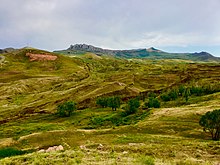Ron Wyatt

Ronald Eldon Wyatt (June 2, 1933 – August 4, 1999), was an American nurse anesthetist and pseudo archaeologist, who claimed to have made almost 100 biblical archaeology discoveries. One of his more notable claims is the supposed landing place of Noah's Ark at the Durupınar site.[1]
Wyatt's claims have been described as "fraudulent",[2] in "the category of trash which one finds in tabloids such as the National Enquirer",[3] and been criticized by scientists, historians, biblical scholars, and some creationists. They are not considered credible by professional archaeologists and biblical scholars.
Life and career
[edit]

Wyatt was working as a nurse anesthetist in a hospital in Madison, Tennessee,[4] when, in 1960, he saw a picture in Life of the Durupınar site, a boat-like shape on a mountain near Mount Ararat. The resulting widespread speculation in evangelical Christian circles that this might be Noah's Ark started Wyatt on his career as an amateur archaeologist. From 1977 until his death, in 1999, he made more than a hundred trips to the Middle East, his interests widening to take in a great variety of references from the Old and New Testaments. By the time of his death, Wyatt claimed to have discovered several sites and artifacts related to the Bible and biblical archaeology.
Death
[edit]Wyatt died of bone cancer, on August 4, 1999, aged 66, at the Baptist Memorial Hospital in Memphis, Tennessee.[5] His remains are buried in Polk Memorial Park Cemetery, in Columbia, Tennessee.[6]
Criticism
[edit]The Garden Tomb Association of Jerusalem states the following, in a letter issued to visitors on request:
The Council of the Garden Tomb Association (London) totally refutes the claim of Wyatt to have discovered the original Ark of the Covenant or any other biblical artifacts within the boundaries of the area known as the Garden Tomb Jerusalem. Though Wyatt was allowed to dig within this privately owned garden on a number of occasions (the last occasion being the summer of 1991) staff members of the Association observed his progress and entered his excavated shaft. As far as we are aware nothing was ever discovered to support his claims nor have we seen any evidence of biblical artifacts or temple treasures.[7]
Joe Zias, an archaeologist of the Israel Antiquities Authority (IAA), has stated that "Ron Wyatt is neither an archaeologist nor has he ever carried out a legally licensed excavation in Israel or Jerusalem. In order to excavate one must have at least a BA in archaeology which he does not possess despite his claims to the contrary. ... [His claims] fall into the category of trash which one finds in tabloids such as the National Enquirer, Sun etc."[3]
Wyatt's official organization, Wyatt Archaeological Research (WAR), claims that the IAA has always been aware of the excavations and issued "verbal permits" for most of them and official permits to all WAR excavations since 2002.[citation needed] Nevertheless, the only evidence of WAR's involvement in a legitimate excavation sanctioned by the IAA relates to WAR's helping to fund a dig in 2005.[8]
Some Evangelicals have also been critical of Wyatt's claims. Answers in Genesis called Wyatt's claims "fraudulent".[2] David Merling, a Seventh-day Adventist and a professor of archaeology, addressed the issues of Wyatt's Noah's Ark and anchor-stones:
While the Durupinar site is about the right length for Noah's ark, [it is]... too wide to be Noah's ark. Wyatt has claimed that the "boat-shapedness" of this formation can only be explained by its being Noah's ark, but both Shea and Morris have offered other plausible explanations. Likewise, Wyatt has argued that the standing stones he has found are anchors, while Terian is aware of similar stones outside the Durupinar site area that were pagan cultic stones later converted by Christians for Christian purposes.[9]
See also
[edit]References
[edit]- ^ Sarkar 2024.
- ^ a b Wieland 2003.
- ^ a b Letter.
- ^ Standish 1999, p. 10.
- ^ Eedle 1999.
- ^ Romano 2001.
- ^ Anchor Stone 1999.
- ^ Zelinger 2006.
- ^ Merling.
Sources
[edit]- Collins, L. G.; Fasold, D. F. (1996). "Bogus "Noah's Ark" from Turkey Exposed as a Common Geologic Structure". Journal of Geoscience Education. 44 (4): 439–444. Bibcode:1996JGeEd..44..439C. doi:10.5408/1089-9995-44.4.439.
- Corbin, B. J. (1999). The Explorers of Ararat and the search for Noah's ark. Great Commission Illustrated Books.
- Eedle, Arthur (10 August 1999). "15. Tribute to Ron Wyatt". Prophetic Telegraph.
- Jarriel, Tom (October 17, 1985). 20/20 October 17, 1985. 20/20. ABC News.
- Romano, Jack (October 2001). "Ron Wyatt: God's Archaeologist". Fortean Times. Archived from the original on 18 March 2013. Retrieved 22 February 2014.
- "Letter from Joe Zias". Tentmaker Ministries.
- Merling, David. ""Has Noah's Ark Been Found?"". Adventists Online. Archived from the original on 1999-11-17. Retrieved 2016-08-09.
{{cite web}}: CS1 maint: bot: original URL status unknown (link) - "Noah's Ark? Boatlike form is seen near Ararat". Life. September 5, 1960. pp. 112–114.
- Qguz, Zeynep (2023). "Geo-Spiritualities of the Flood: Political Geologies of the Great Deluge on the Mountains of Anatolia". In Bashford, Alison; Kern, Emily M.; Bobbette, Adam (eds.). New Earth Histories : Geo-Cosmologies and the Making of the Modern World. University of Chicago Press.
- Sarkar, Donna (February 8, 2024). "The True Story Of Amateur Christian Archaeologist Ron Wyatt And His Biblical 'Discoveries'". All That's Interesting. Retrieved 28 May 2024.
- Standish, Russell R. (1999). Historic Adventism: What are the Chief Beliefs of what Has Become Known as "Historic Adventism"?. Hartland Publications. ISBN 978-0-923309-64-0.
- "Update: Ark of the Covenant". Anchor Stone International. March 28, 1999.
- Wieland, Carl (February 11, 2003). "AiG discussion of Wyatt and other claims with Kent Hovind, October/December 2002". Archived from the original on February 11, 2003. Retrieved July 10, 2013.
- Zelinger, Yehiel (2006). "Jerusalem, the Garden Tomb". Hadashot Arkheologiyot. 116. Israel Department of Antiquities and Museums.
